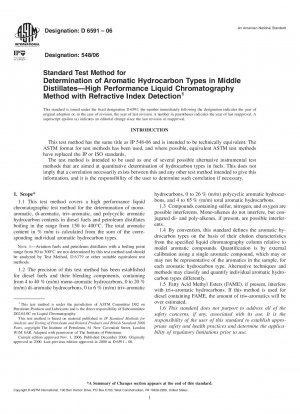ASTM D6591-06
Standard Test Method for Determination of Aromatic Hydrocarbon Types in Middle Distillates-High Performance Liquid Chromatography Method with Refractive Index Detection
- Standard No.
- ASTM D6591-06
- Release Date
- 2006
- Published By
- American Society for Testing and Materials (ASTM)
- Status
- Replace By
- ASTM D6591-11
- Latest
- ASTM D6591-19
- Scope
The aromatic hydrocarbon content of motor diesel fuel is a factor that can affect exhaust emissions and fuel combustion characteristics, as measured by cetane number.
The United States Environmental Protection Agency (US EPA) regulates the aromatic content of diesel fuels. California Air Resources Board (CARB) regulations place limits on the total aromatics content and polynuclear aromatic hydrocarbon content of motor diesel fuel, thus requiring an appropriate analytical determination to ensure compliance with the regulations.
This test method is applicable to materials in the same boiling range as motor diesel fuels and is unaffected by fuel coloration. Test Method D 1319,
which has been mandated by the US EPA for the determination of aromatics in motor diesel fuel, excludes materials with final boiling points greater than 315°C (600°F) from its scope. Test Method D 2425 is applicable to the determination of both total aromatics and polynuclear aromatic hydrocarbons in diesel fuel, but is much more costly and time-consuming to perform. Test Method D 5186, currently specified by CARB, is also applicable to the determination of both total aromatics and polynuclear aromatic hydrocarbons in diesel fuel. Test Method D 5186, however, specifies the use of supercritical fluid chromatography equipment that may not be readily available. Note 28212;Test Method D 5186
was previously specified by CARB as an alternative to Test Method D 1319 . 1.1 This test method covers a high performance liquid chromatographic test method for the determination of mono-aromatic, di-aromatic, tri+-aromatic, and polycyclic aromatic hydrocarbon contents in diesel fuels and petroleum distillates boiling in the range from 150 to 400176;C. The total aromatic content in % m/m is calculated from the sum of the corresponding individual aromatic hydrocarbon types.
Note 1Aviation fuels and petroleum distillates with a boiling point range from 50 to 300176;C are not determined by this test method and should be analyzed by Test Method, D 6379 or other suitable equivalent test methods.
1.2 The precision of this test method has been established for diesel fuels and their blending components, containing from 4 to 40 % (m/m) mono-aromatic hydrocarbons, 0 to 20 % (m/m) di-aromatic hydrocarbons, 0 to 6 % (m/m) tri+-aromatic hydrocarbons, 0 to 26 % (m/m) polycyclic aromatic hydrocarbons, and 4 to 65 % (m/m) total aromatic hydrocarbons.
1.3 Compounds containing sulfur, nitrogen, and oxygen are possible interferents. Mono-alkenes do not interfere, but conjugated di- and poly-alkenes, if present, are possible interferents.
1.4 By convention, this standard defines the aromatic hydrocarbon types on the basis of their elution characteristics from the specified liquid chromatography column relative to model aromatic compounds. Quantification is by external calibration using a single aromatic compound, which may or may not be representative of the aromatics in the sample, for each aromatic hydrocarbon type. Alternative techniques and methods may classify and quantify individual aromatic hydrocarbon types differently.
1.5 Fatty Acid Methyl Esters (FAME), if present, interfere with tri+-aromatic hydrocarbons. If this method is used for diesel containing FAME, the amount of tri+-aromatics will be over estimated.
This standard does not purport to address all of the safety concerns, if any, associated with its use. It is the responsibility of the user of this standard to establish appropriate safety and health practices and determine the applicability of regulatory limitations prior to use.
ASTM D6591-06 Referenced Document
- ASTM D1319 Standard Test Method for Hydrocarbon Types in Liquid Petroleum Products by Fluorescent Indicator Adsorption
- ASTM D2425 Standard Test Method for Hydrocarbon Types in Middle Distillates by Mass Spectrometry
- ASTM D4057 Standard Practice for Manual Sampling of Petroleum and Petroleum Products
- ASTM D4177 Standard Practice for Automatic Sampling of Petroleum and Petroleum Products
- ASTM D5186 Standard Test Method for Determination of Aromatic Content and Polynuclear Aromatic Content of Diesel Fuels and Aviation Turbine Fuels by Supercritical Fluid Chromatography
- ASTM D6379 Standard Test Method for Determination of Aromatic Hydrocarbon Types in Aviation Fuels and Petroleum Distillates-High Performance Liquid Chromatography Method with Refractive Index Detection
ASTM D6591-06 history
- 2019 ASTM D6591-19 Standard Test Method for Determination of Aromatic Hydrocarbon Types in Middle Distillates—High Performance Liquid Chromatography Method with Refractive Index Detection
- 2018 ASTM D6591-18 Standard Test Method for Determination of Aromatic Hydrocarbon Types in Middle Distillates—High Performance Liquid Chromatography Method with Refractive Index Detection
- 2011 ASTM D6591-11(2017) Standard Test Method for Determination of Aromatic Hydrocarbon Types in Middle Distillates&x2014;High Performance Liquid Chromatography Method with Refractive Index Detection
- 2011 ASTM D6591-11 Standard Test Method for Determination of Aromatic Hydrocarbon Types in Middle Distillatesmdash;High Performance Liquid Chromatography Method with Refractive Index Detection
- 2006 ASTM D6591-06 Standard Test Method for Determination of Aromatic Hydrocarbon Types in Middle Distillates-High Performance Liquid Chromatography Method with Refractive Index Detection
- 2000 ASTM D6591-00 Standard Test Method for Determination of Aromatic Hydrocarbon Types in Middle Distillates-High Performance Liquid Chromatography Method with Refractive Index Detection
